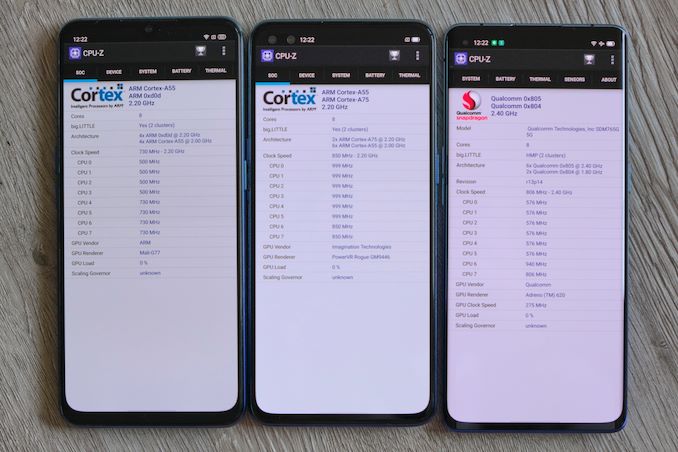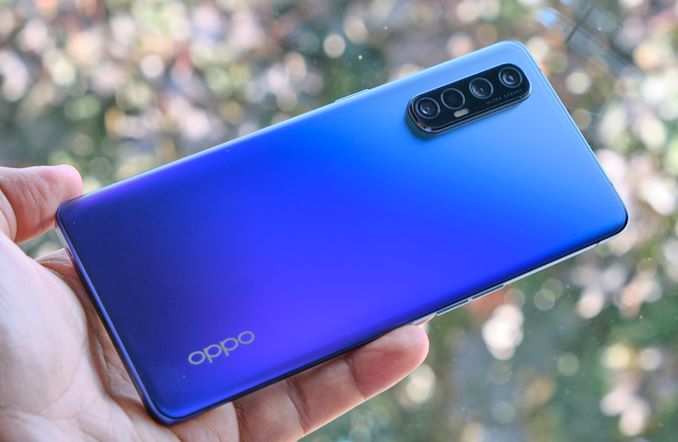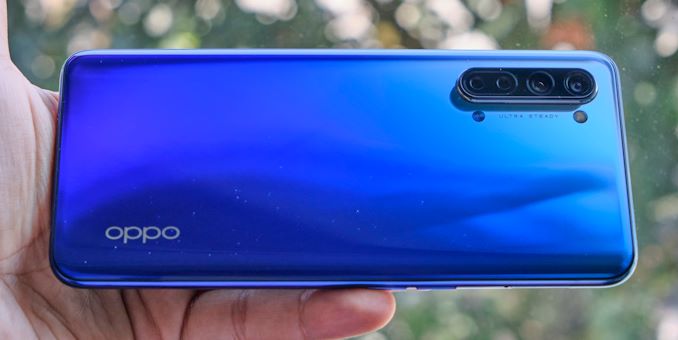OPPO's Reno3 5G vs Reno3 Pro vs Reno3 Pro 5G: Why Don't We See More MediaTek Dimensity 1000 Phones?
by Andrei Frumusanu on August 10, 2020 10:00 AM EST
The last 2 years have been quite exciting for the mobile silicon landscape – Arm’s release of the Cortex-A76 had marked a big jump in performance for smartphones, vastly raising the bar of what is possible to achieve in a mobile SoC. With this generation, we’ve also seen SoC vendors deploy some increasingly competitive designs that improved upon their predecessors – much to do with the new IP, but also a large part thanks to new 7nm manufacturing technologies.
We’re all too familiar with Qualcomm’s Snapdragon 855 and 865 which power the majority of flagship devices in the market right now. Qualcomm has been steadily improving their execution of the last couple of years ever since the Snapdragon 835, and the new S865 is really a great balance between performance and power efficiency for 2020’s devices. We’ve also seen HiSilicon push out quite competitive products with the Kirin 980 and the 990 – although the future of Huawei’s in-house SoC designs are in grave limbo and run the risk of no longer seeing successors in the future.
Qualcomm’s and HiSilicon’s successes have however come at a cost in the market though – we’re all aware of Samsung’s missteps with their Exynos series, although we do hope things will improve in the comings years, fingers crossed.
The other victim to Qualcomm and Huawei’s success has been MediaTek. The Taiwanese SoC vendor had been traditionally been a larger player in the smartphone market, however it’s been losing market share to Qualcomm quarter after quarter for years now. Last year, the company had revealed that with the new 5G generation of “Dimensity” SoCs we’d be seeing a renewed push into the high-end market.
Today, we’ll be taking a closer look at one of these Dimensity 1000 powered phones, the OPPO Reno3 5G. The Reno3 series has been quite the oddball device line-up this year, as the company has been selectively releasing quite different variants at a rapid pace in different markets – all with different SoCs and slightly differing device specs.
| Some OPPO Reno3's | |||
| Reno3 5G (China only) |
Reno3 Pro (Global variant) |
Reno3 Pro 5G a.k.a Find X2 Neo |
|
| SoC | Dimensity 1000L 4x Cortex A77 @ 2.2GHz 4x Cortex A55 @ 2.0GHz Mali-G77MP7 @ 695 MHz |
Helio P95 2x Cortex A75 @ 2.2GHz 6x Cortex A55 @ 2.0GHz PowerVR GM 9446 @ 970MHz |
Snapdragon 765G 1x Cortex A76 @ 2.4GHz 1x Cortex-A76 @ 2.2GHz 6x Cortex-A55 @ 1.8GHz Adreno 620 |
| Display | 6.4-inch OLED 2400 x 1080 (20:9) |
6.4-inch OLED 2400 x 1080 (20:9) |
6.5-inch OLED 2400 x 1080 (20:9) 90Hz |
| Dimensions | 160.3 x 74.3 x 8 mm 181 grams |
158.8 x 73.4 x 8.1mm 175 grams |
159.4 x 72.4 x 7.7 mm 171 grams |
| RAM | 8/12GB LPDDR4X | 8GB LPDDR4 | 8/12GB LPDDR4X |
| NAND Storage |
128GB UFS 2.1 | 128/256GB | 128/256GB UFS 2.1 |
| Battery | 4025mAh (15.57Wh) typ. 3935mAh (15.22Wh) rated |
||
| VOOC Flash Charge 4.0 30W |
|||
| Front Camera | 32MP f/2.0 | 44MP f/2.4 + 2MP f/2.4 |
32MP f/2.0 |
| Primary Rear Camera | 64MP IMX686 1/1.73" 0.8µm f/1.8 w/ OIS |
48MP IMX586 1/2.0" 0.8µm f/1.7 w/OIS |
|
| Secondary Rear Camera |
8MP 1.4µm f/2.25 119° Ultra-wide |
||
| Tertiary Rear Camera |
2MP depth portrait f/2.4 |
13MP 1/3.4" 1.0µm Telephoto |
|
| Extra Camera |
2MP black & white portrait f/2.4 |
2MP black & white portrait f/2.4 |
2MP black & white portrait f/2.4 |
| 4G / 5G Modem |
5G Sub-6 Integrated | 4G LTE | 5G Sub-6 Integrated |
| SIM Size | Dual nanoSIM | ||
| Wireless | 802.11a/b/g/n/ac/ax 2x2 MU-MIMO, BT 5.0 LE, NFC, GPS/Glonass/Galileo/BDS |
802.11a/b/g/n/ac 2x2 MU-MIMO, BT 5.0 LE, NFC, GPS/Glonass/Galileo/BDS |
802.11a/b/g/n/ac/ax 2x2 MU-MIMO, BT 5.0 LE, NFC, GPS/Glonass/Galileo/BDS |
| Connectivity | USB Type-C 3.5mm headset |
USB Type-C | |
| Special Features | In-screen fingerprint sensor | ||
| Launch OS | Android 10 | ||
All in all – there’s 4 different variants of the “Reno3”, with the key characteristic being that we’re seeing quite different devices in the Chinese market compared to the international counterparts. We have had our hands on 3 of these for several months now:
The Chinese market Reno3 5G is the most interesting device today as it’s the one phone that employs MediaTek’s newest Dimensity 1000 SoC. To be precise, this is a “1000L” lower-binned variant of the chip that slightly differs in clocks speeds and GPU configuration. Originally planned for 4x 2.6GHz Cortex-A77 cores with 4x 2.0GHz Cortex-A55 cores and a Mali-G77MP9 at 800+MHz, the new lower-binned chip only clocks the big cores at 2.2GHz, and disables two GPU cores to make it an MP7 configuration at 695MHz. Strangely enough, this May we saw MediaTek re-release the chip in the form of the Dimensity 1000+ with the full specifications that were originally promised late last year.
The Chinese market also received the Reno3 Pro 5G – a higher-end variant of the phone with a different design, powered by Qualcomm’s Snapdragon 765G SoC. This product positioning was quite weird, as on paper, you’d expect the regular Reno3 5G actually outperform the Pro 5G variant – and this is actually the most interesting topic we’ll be addressing today. The Snapdragon 765 features older Cortex-A76 cores, one at 2.4GHz, and one at 2.2GHz, alongside 6x Cortex-A55’s at 1.8GHz, and has the Adreno 620 as its GPU.
The interesting thing also about the Reno3 Pro 5G is that a few months after the Chinese launch, we’ve actually seen the device come to international markets, but this time marketed as the Find X2 Neo.
The Reno3 and Reno3 Pro in international markets are seemingly quite shadows of their Chinese counterparts. The Reno3 comes with a 2018 launched MediaTek P90 chipset, while the Reno3 Pro using a P95 that doesn’t really change much at all in the configuration of the chip beyond a slight clock boost to its AI engine. The 2x Cortex-A75 cores at 2.2GHz with 6x A55’s at 2.0GHz and an ImgTech PowerVR GM 9446 GPU at 970MHz are all quite outdated in 2020 – with the SoC being fabricated on an older 12nm process.
The Reno3 Pro also has very little to do with the Reno3 Pro 5G other than their naming – the latter is clearly a higher-end device in terms of design and screen.
The piece today isn’t much of a device review as it’s more focused on the SoC differences between the phones, with an emphasis on the MediaTek Dimensity 1000L on the Chinese Reno3 5G.
The Reno3 phones are actually outdated by this point in time as the company has followed up with the Reno4 series in China – a slight design iteration on the previous gen, mixing and mashing specifications again whilst retaining the Snapdragon 765G and dropping MediaTek as a SoC source, making today’s article all the more intriguing.












44 Comments
View All Comments
s.yu - Monday, August 10, 2020 - link
Reno 3 ProSheep. Whoever buys that device for the Pro moniker thinking its gonna be better has got to be pro at being sheep.mfaisalkemal - Monday, August 10, 2020 - link
Hi Andrei,I think IMG A-Series 2.5x improvement claim still impressive because at 12nm(iso node process, area and power like Helio P90) compared to snapdragon 765g at 7nm.If I multiply 2.5 times to your all GPU benchmarks, IMG A-Series ahead all snapdragon 765g scores except Aztec ruin(I hope A-Series architecture have improvement on that benchmark compared to PowerVR GM9446).
Do you know how many peak system active power(minus screen power) of Reno 3 pro(Helio p95) Andrei?
Beaver M. - Tuesday, August 11, 2020 - link
The hardware is often excellent on these Chinese phones. No matter if Oppo, Xiaomi, Huawei, etc.But the software and its support is horrible. The customization of Android is horribly buggy and overdone, especially the power saving "features". They often offer whitelists for apps, but they actually dont work. Not even Gmail is working in the background, not to mention apps from 3rd parties. They even end background apps automatically after a few hours or days without you realizing. Imagine someone for example with diabetes using and 3rd party app for alarms...
And then of course the support ends very quickly (around 2 years) and even simple security patches often break a lot.
Sad, really. A real waste.
I had high hopes in BQ, a Spanish producer, because their support and small customizations of Android were absolutely awesome, not to say perfect. But they got bought by a Vietnamese corporation and stopped producing phones after that.
Retycint - Tuesday, August 11, 2020 - link
Do you actually have any sources for your claims? As far as I am aware, the software support for Xiaomi flagships, at least, are pretty good. The Android version may not be updated that much but the features trickle in via MIUI updates so it doesn't really matterRetycint - Tuesday, August 11, 2020 - link
For instance, the Mi MIX 2 released in 2017 September is still slated to receive the latest MIUI. That's literally 3 years of software support, which is something only matched by Pixel and OnePlus (and Samsung, but only their newer devices)Beaver M. - Tuesday, August 11, 2020 - link
I had several Huawei, Honor, Xiaomi, Oppo and others.Sure, sometimes after many months a few get a security patch. Like the Honor 9 from 2017 lately, that didnt get a security patch since July 2019, and then suddenly got the May 2020 security update and some added features. But thats really nothing to be proud of. You cant really take that for granted either. It pretty much happens randomly.
sonny73n - Tuesday, August 11, 2020 - link
Of course he does not have any evident or source to back up his claims. He’s just like other Apple sheep thinking that every “security” update is actually security update.Beaver M. - Wednesday, August 12, 2020 - link
Oh, so someone who hasnt owned anything Apple since 2008 and most likely wont ever again, is an "Apple sheep."Makes sense, sonny. :thumbsup:
Ptosio - Wednesday, August 12, 2020 - link
Which makes you wonder: what won't these manufacturers release more pure Android headsets? It shouldn't be so hard...flyingpants265 - Tuesday, August 11, 2020 - link
Boycott this phone, Realme X is the same thing for $142 USD. Artificially limited and sold in Asia only or something.